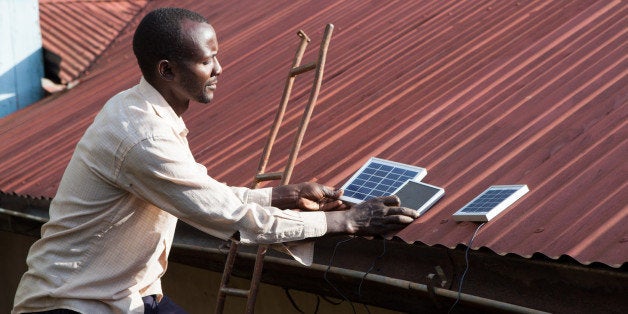
After two days of driving across the vast, roadless interior of Chad, we stumbled upon a remarkable sight: two men on camels, wrapped in robes and navigating by the sun and wind. They dismounted and offered us camel's milk, despite the fact that they were carrying almost no food or water for themselves. But tradition dictated a gift upon greeting strangers, so they offered what they had. We politely declined and gave them extra supplies before they continued on their way. It was my first time encountering people who have never had access to any kind of modern infrastructure.
It was 2010, and I was a member of a rock-climbing expedition to the Ennedi desert in the remote Northeastern corner of Chad. The three days spent driving across the Sahel were my first time experiencing anywhere so remote. So when we met the local people living in huts in the Ennedi and herding goats, much as they had for thousands of years, it was quite a shock for someone who grew up in suburban California.
At the time, our trip to Chad just felt like simple adventure tourism. We put up new routes on untouched rock and we documented it for The North Face, our main sponsor. It was a successful trip, in that we explored a new area and did some great climbing. But the trip stayed with me -- it was the first time I was confronted face first with true poverty.
As a professional rock climber, I've been traveling pretty much nonstop for the last decade. I live out of my van, which gives me a first-hand appreciation for power and lighting. A few years ago, I rebuilt the interior of my van to include solar panels and a battery that powers LEDs for lighting and allows me to charge my phone and laptop. This is exactly the same type of small-scale home solar system that is starting to take off all over Africa. It's easy to forget the impact that something as simple as a light bulb can have on your quality of life -- I can appreciate first hand how much my life improved once I had access to consistent lighting and power inside my home.
In the years after the expedition to Chad, I started the Honnold Foundation, a small nonprofit that was my attempt to do something positive in the world. I sought out projects that both helped the environment and improved peoples' standards of living. The more I researched, the more I gravitated toward solar.
Currently 1.3 billion people live without access to grid-connected power in the world, and this number grows every year. They rely on things like kerosene lanterns for light or diesel generators for AC power. Both options are extremely expensive, with people in some parts of Africa spending more than 25 percent of their income just on kerosene for lighting. But more importantly, burning fossil fuels in a confined space leads to terrible health issues. According to the World Bank, 800,000 people die every year from indoor air pollution.
However, this problem is also a terrific opportunity, and there are now dozens of different companies and nonprofits selling solar systems of all types and sizes across Africa. The most interesting of these have borrowed the model of telecom companies and offer pay-as-you-go systems as a way to avoid the high initial costs of ownership. That way, families can make small monthly payments -- much smaller than their current fuel expenses -- and gain access to a safer, cleaner way to light and power their homes.
Much as Africa has leapfrogged straight to mobile phones, it has the opportunity to skip the dirty, grid-tied power plants that currently operate across the developed world and go straight to clean, distributed power. In that light, it will be a closely watched proving ground for the UN's Sustainable Development Goal 7, which aims to "ensure access to affordable, reliable, sustainable and modern energy for all." Interestingly, this solar revolution across Africa is also an extremely democratic trend, since the people with the most need are able to help themselves and improve their own lives. In fact, there are anecdotes of warlords in Iraq and Afghanistan controlling small communities by owning the generators that power them.
There is less need for massive government-financed transmission and distribution projects -- just small kiosks around the countryside from which the local people can buy what they need.
This trend toward clean, distributed power is gaining momentum across the globe. But it's in the developing world that there's the most need and the most opportunity. The Honnold Foundation has been trying to support this trend in our own small way through grants to groups like Solar Aid and an exploratory solar project in Angola this fall. Nonetheless, while it's been very satisfying to do our small part to help, it will ultimately be the individual choices of the local populations that lead them to clean energy.
This post is part of a series produced by The Huffington Post, "What's Working: Sustainable Development Goals," in conjunction with the United Nations' Sustainable Development Goals (SDGs). The proposed set of milestones will be the subject of discussion at the UN General Assembly meeting on Sept. 25-27, 2015 in New York. The goals, which will replace the UN's Millennium Development Goals (2000-2015), cover 17 key areas of development -- including poverty, hunger, health, education, and gender equality, among many others. As part of The Huffington Post's commitment to solutions-oriented journalism, this What's Working SDG blog series will focus on one goal every weekday in September. This post addresses Goal 7.